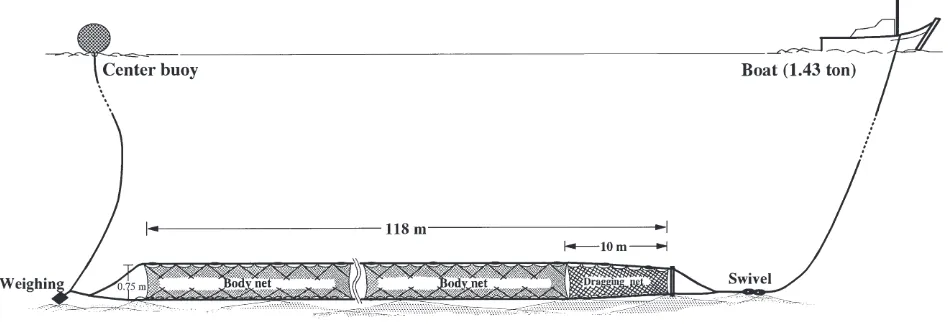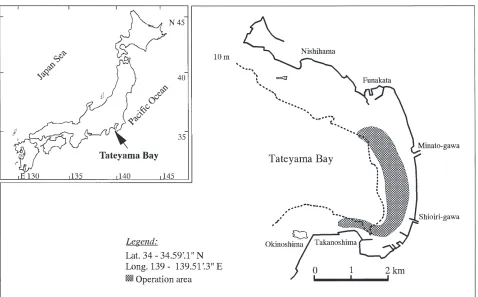FISHERIES SCIENCE2000;66: 97–103
INTRODUCTION
A sweeping trammel net is a typical entangling net with a sweeping process for increasing the encounter chances between fish and gear. In Japan, it is used for capturing demersal species, such as branquillos Branchiostegus japonicusalong the coast of the Japan sea1and Japanese
whiting Sillago japonica in Tokyo Bay.2 Although this
fishing gear is classified in the same category as a gill net,3
it has a characteristic selectivity curve different from gill nets due to the differences in capture condition as well as its operation method.4In gill nets most captured
indi-viduals become gilled and wedged within a single-walled net, while in the trammel nets large-sized fish are caught by pocketing, which is different from the entangling occurring in a gill net.5It was observed that the
sweep-ing trammel net in Tateyama Bay, Chiba Prefecture, Japan caught small Japanese whiting (<160 mm) mainly by gilling, while medium- (160–200 mm) and large-sized fish (>200 mm) mainly by entrapment into the pockets.2
Generally, the selectivity pattern of the trammel net for fin-fish depends on the mesh size and the slackness of its inner net.6Some studies4,7–12reported that mesh
selec-tivity curve of the gear skewed to the right side and had a wider selection range of 50% relative efficiency with the increase of slackness. Kitahara4was the first to report
on the selectivity of sweeping trammel nets for Bran-chiostegus japonicusshowing a positive skew of selectivity curve. For Sillago japonica, however, the selectivity of the sweeping trammel net has not yet been determined. With recent increasing needs on resource management for the sustainable coastal fisheries, the improvement of gear selectivity is of urgent importance.
The purpose of this study was to determine the mesh selectivity of the sweeping trammel net for Japanese whiting Sillago japonica, with the experimental fishing operation using different mesh sizes for the inner net.
MATERIALS AND METHODS
Specification of the sweeping trammel net
One set of a sweeping trammel net operating in Tateyama Bay, Chiba Prefecture, Japan usually consists of six pieces of triple-walled net (18 m long and 0.75 m deep per piece)
Original Article
Mesh selectivity of a sweeping trammel net for
Japanese whiting
Sillago japonica
Ari PURBAYANTO,1
* Seiji AKIYAMA,2Tadashi TOKAI2AND Takafumi ARIMOTO2
1
Faculty of Fisheries and Marine Science, Bogor Agricultural University, Bogor, Indonesia and 2
Department of Marine Science and Technology, Tokyo University of Fisheries, Konan, Minato, Tokyo 108-8477, Japan
SUMMARY: To determine the mesh selectivity of a sweeping trammel net for Japanese whiting Sillago japonica, experimental fishing operations using three different inner net mesh lengths (27.5, 31.0 and 33.5 mm) were carried out in Tateyama Bay, Chiba Prefecture, Japan from August to Novem-ber 1996 and from April to May 1997. The length mode of captured fish increased in proportion to the mesh length from 150–160 mm of the smallest mesh to 190–200 mm total length of the largest mesh. The master curve of selectivity in terms of length ratio to the mesh length (l/m) showed a wide selection range of 50% relative efficiency compared to the mesh selectivity curve of gill net. The curve had a peak at l/m of 6.3 with the selection range from 5.4 to 7.4. This suggested that the trammel net caught a large number of entangled or pocketed fish in comparison to the gilled fish due to the effect of inner net slackness. In terms of body girth ratio to mesh perimeter (G/P), the curve had a peak at G/P of 1.31, which reflected that relative efficiency of capture reached its maximum when the body girth of fish was 1.31 times that of the mesh perimeter.
KEY WORDS: body girth, Japanese whiting, master curve, mesh selectivity, sweeping
trammel net.
Experimental fishing operations
The experimental fishing operations were carried out in a sandy or sandy-mud fishing ground of 5–10 m depth in Tateyama Bay (Fig. 2), during two periods from August to November 1996 and from April to May 1997. Five fishing trips with 47 hauls and four trips with 34 hauls were done in 1996 and 1997, respectively.
The experimental fishing operation with a commer-cial boat was as follows.2 First, the net was set on the
seabed along the direction of right angle to offshore after shooting a center buoy. Next, the end of the drag net was towed with the towing rope for sweeping over the seabed around the center buoy. Finally, the net was hauled up with a small-mechanized net hauler, while the catch was removed from the mesh carefully by hand. One round of the operation required 23 min on average.
To minimize effects of the net position2on the catch
saturation and net-piece interaction,13the arrangement
of the different mesh nets was alternated for each fishing trip during the experimental operations. With a total of nine trips operating 81 hauls, the nets of 27.5, 31.0 and attached with one piece of drag net (10 m long) at one
end of the towing side, with a total of 118 m length (Fig. 1). For capturing Japanese whiting, the inner net of 27.5 mm mesh length with the outer net of 300 mm mesh length is currently used. Larger inner net mesh lengths of 30.0 mm and 32.5 mm of nominal sizes were employed here in order to compare the catch size distribution against the 27.5 mm nominal mesh length. Careful mea-surements of mesh lengths for three mesh sizes showed the variation of actual lengths against the nominal lengths in the case of the larger meshes. The actual mesh lengths of 27.5, 31.0 and 33.5 mm are discussed for further analytical procedures on mesh selectivity curve. The mesh length is defined as the stretched net mesh measur-ing from one center of a knot to the other.
The webbing of the nets was a nylon multifilament (i.e. PA-210 D/2 for the inner net, PA-210 D/6 for the outer net, and PA-210 D/9 for the dragging net). The hanging ratio of the outer net was 0.65 and the inner net was 0.47, while the slackness of the inner net ranged from 1.83 to 1.99. Detailed description of the experi-mental sweeping trammel net is presented in Table 1.
98 FISHERIES SCIENCE A Purbayantoet al.
Fig. 1 Schematic diagram of sweeping trammel net operated in Tateyama Bay, Chiba Prefecture, Japan.
Table 1 Specification of an experimental sweeping trammel net used in the experiment
Net parts Materials Mesh length Completed length Hanging ratio Height Slackness (mean±SD mm) Float line Sinker line Float side Sinker side of net
(m) (m) (m)
Inner net 1 Nylon 210 D/2 27.5±0.13* 18.07 18.15 0.48 0.48 0.75 1.83 Inner net 2 Nylon 210 D/2 31.0±0.37 18.07 18.15 0.47 0.47 0.75 1.92 Inner net 3 Nylon 210 D/2 33.5±0.35 18.07 18.15 0.47 0.47 0.75 1.99
All outer nets Nylon 210 D/6 300 18.07 18.15 0.65 0.66 0.75
Float Plastic 19 gf Sinker Clay 6.5 g
33.5 mm mesh length were considered to have the same fishing power at different net positions. All the Japanese whiting caught by each different mesh length were mea-sured in total length (TL) and maximum body girth to the nearest millimeter. The capture conditions of fish (i.e. snagged, gilled, entangled, and pocketed)2were also
recorded. The maximum body girth was measured by means of encircling a polyethylene string of 1.2 mm diameter around the head part of fish just in front of the dorsal fin.
Estimation of mesh selectivity curve
The measurement data collected during the experimen-tal fishing operations were pooled separately for each mesh length of 27.5, 31.0, and 33.5 mm, respectively. The data of total length were grouped into 10 mm inter-vals. Here, a single curve for selectivity (referred to as the master curve) was estimated using Kitahara’s method.4 The catch per unit effort C
ijof the Japanese
whiting at j-th length class lj(j=1, 2, . . .l) with i-th
mesh length mican be expressed as follows:
(1)
where s(lj/mi) is the mesh selectivity, i.e. a function of the
relative efficiency, and its maximum is 1, against the ratio
Cij =s l m qdj(j i)
of body length ljto mesh length mi, and qdenotes the
efficiency at the peak of mesh selectivity curve and djis
population density of the fish at length lj. It is assumed
that q is ordinarily constant if relative efficiency is considered.
Taking logarithm for both sides of Eqn 1 gives:
(2)
where Dj=qdj.
The master curve of mesh selectivity s(lj/mi) was
approximated by a polynomial curve12expressed by the
following equation:
(3)
where Ris equal to lj/mi, and smaxis the maximum value
of the approximated curve. Parameters, an, an-1, . . .ao
(n=1, 2, . . .m) and Dj(j=1, 2, . . .l) are to be estimated
using non-linear least square method.14 The degree of
polynomial function was determined by comparing the values of unbiased estimator for variance of errors (s2)
between the functions of different degree as follows:
(4)
where p= m +(l -1)
s2=q (p-p)
s R( )=exp
{
(
a Rn n+an-1Rn-1+an-2Rn-2. . .+ao)
-smax}
log log log
log log
C s l m qd s l m D
ij j i j
j i j
= ( )+
= ( )+
Sweeping trammel net selectivity for Japanese whiting 99

